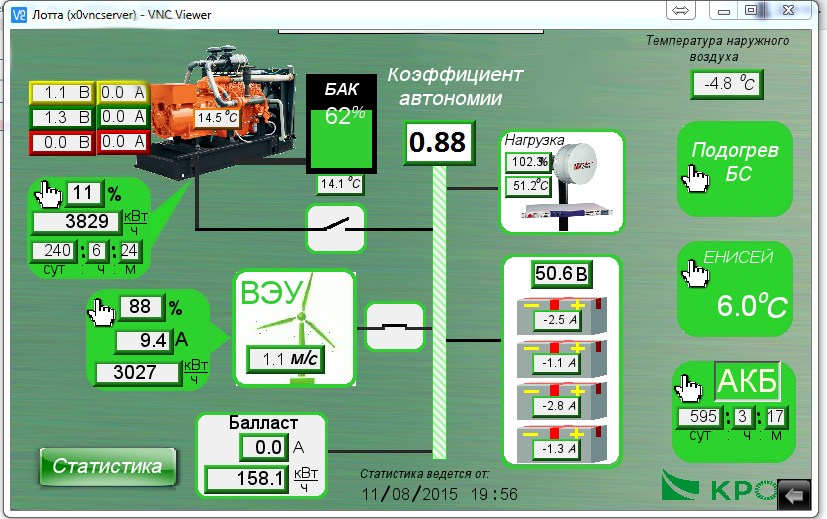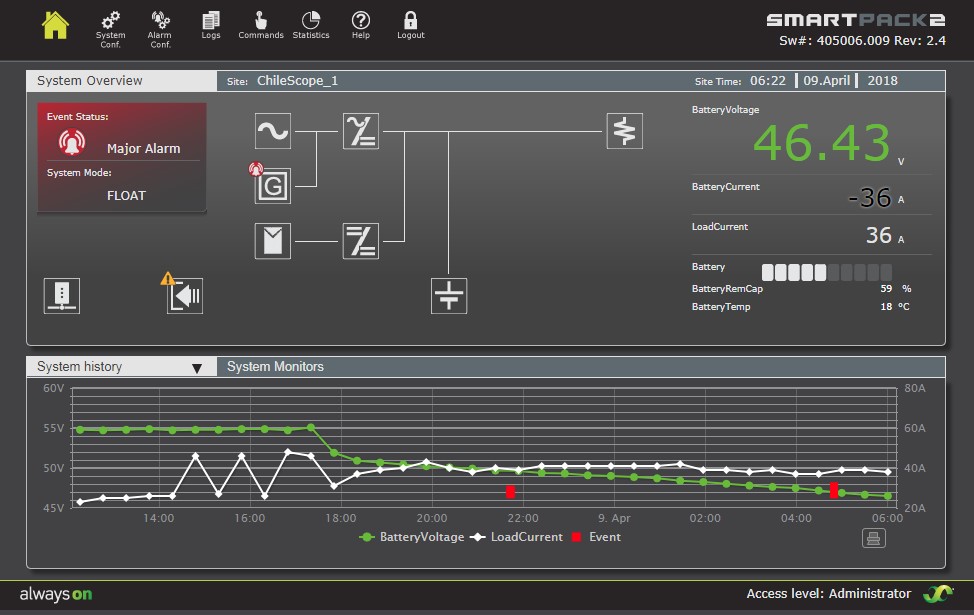
Hello! I will talk about geo-cooling and geo-heating of cellular network base stations, wind generation, solar energy practice (in particular, for the observatory), heat and energy generation from biological waste, cooling the data center from the river, optimization of classical systems and a little about managing all this software.
Let's start with the river in Siberia:
Designed a data center near the CHP. A CHP is powered by water from the river. Actually, the water temperature in the river is from 0 to +15, and the CHP must be +25. We thought: how wonderful it is that someone needs warm water! And sat down with a heat exchanger at this feed. As a result, we preheat the water by an average of one degree (depending on the computational load and the season) and transfer a little warmer to the circuit of the CHP. From CHP will not lose, but for us it turns out very effectively. PUE data center - 1.15 all year round.
Base station autonomy
Here
in the post had more details.

In short, we tried to provide autonomous power to several base stations. Used wind generation and solar panels. There were difficulties with the choice of a wind turbine, the choice of batteries, installation, a wind turbine that was blown away by a cruel and merciless wind, and many other adventures. As a result, everything works in Samara and Murmansk. We develop the theme, including ready to build large systems. Now we communicate with potential customers in the Far East.

An example of the interface of the power supply monitoring and control system of autonomous base stations:


We also tried a geo probe on them: a well with a depth of 30 to 100 meters is drilled. Below, the stable temperature for central Russia is about 6–10 degrees all year round. Depending on the thermal conductivity of the soil material, it is possible to provide about 50 W of thermal power per meter of geo-probe length. We ran around the circuit for heating the base station in winter and utilizing the excess heat from the equipment in summer (that is, cooling the station).
The result - yes, it works, it is inexpensive + operation and maintenance costs almost nothing. And it works like a tank - reliably. There are no problems with these installations, but there is little money in this area, so for the time being we have suspended experiments. The system itself is so cheap that it is unprofitable to sell it, since the overhead is more expensive than it costs. There is a feeling that in some regions this will be in demand.
Perhaps, for objects where there is a limitation on the input power, the exact temperature regime is not very critical. Directly you take from the ground +8, you feed water, it passes through the heat exchanger and comes back warmed up, say, 10–12 degrees. And you easily maintain the range inside. In winter - the opposite. Over the summer, the ground warms up - so that in the winter around the base station the grass is already green. And behind it - the snow. Over the summer, the land was so warmed up around, to a depth of 30 meters there, that it could not freeze it all winter, it gives up everything and gives off heat. We started here from +8, at the end of the summer we have, let's say, +18 land. Costs - well price and pump.
Our merit is that we understand how everything works and what is really needed. The geo-cooling and the needs of the base station were optimally combined. That is, under a certain task, we found the optimal solution. What can be done with a much wider range of temperatures, what can be saved inside electricity, what can one do without a chiller with one pump - few people think about it.
Autonomy of the observatory
Here
, my colleagues from the engineering special detachment told how they traveled to Chile to assemble the power unit and the IT stuffing of the station, and how immediately "something went wrong."
 A local contractor installed domes, solar panels, and cable channels. And immediately I fell asleep safely, so that rodents would not climb - and we could not push the cable
A local contractor installed domes, solar panels, and cable channels. And immediately I fell asleep safely, so that rodents would not climb - and we could not push the cable100% autonomous power supply to the observatory in Chile (no external power supply is supplied to it at all) - completely our development (based on the equipment of the vendors), we designed the HLD, LLD of most of the systems and ensured the integration of everything. There are many autonomous controls: the observatory server itself controls the power supply parameters, loads the solar panels, controls the charge of the solar panels, starts and stops the standby (emergency) station power supply (diesel), and controls the power supply itself. In addition, the server itself reacts to security events like crossing the perimeter, switches channels itself and reloads the router. In general, there is nothing cosmically complicated, just a lot of consoles are tied into one dashboard and a bunch of scripts are screwed up - to the stage when it became almost a framework.
 The sun was over, the sunset had gone - the batteries began to discharge. By sunset, there was a load. This is the battery current. Load jumps, jumps. Then, most likely, this cooling of the telescopes turned on
The sun was over, the sunset had gone - the batteries began to discharge. By sunset, there was a load. This is the battery current. Load jumps, jumps. Then, most likely, this cooling of the telescopes turned onNow we are planning to integrate a 0.5 MW solar power plant into the project of a data center in the country with a similar solar profile.
Heat and power generation from household and industrial waste
Already, we have worked out solutions that are ready to be put into operation. This is an interesting topic for agrarian complexes and industries with large volumes of industrial waste, large settlements with problems of garbage disposal. This is a very serious question, since it solves two problems at once - both garbage and energy. And profitable.
There is a legally established list of types of renewable energy sources, and among other things they include household and industrial waste, in particular waste from meat processing plants and farms. You can recycle skin, dung, cow or bird dung, get biogas and fertilizer, or burn bones and get the purest coal. You can recycle just garbage, that is stored in landfills, and that in sewage treatment plants (which is released from the water, well, mostly fecal matter). This is a good raw material for processing - for example, for thermolysis.
And burning is not so easy. Just burn to dispose ... Such plants are already planned to be done in the Moscow region, Kazan and Tula region. But it is possible to arrive and where it is more artful, using different chemical processes, high temperatures of burning.
More interesting is burning, for example, thermolysis: the point is that the garbage is not burned, but heated at a low temperature and gas starts to be emitted from it. And now the gas is burned. Rubbish a little less in volume becomes and continues its life course on pressure testing and / or dump.
And even more interesting is the deep burning of waste: it turns out pure carbon (that is, almost activated carbon). But here the temperatures are already childish, melting metals. In Europe, it works well. They have a demand for this kind of coal, including medicine. The product is well worth it, it's expensive.
Manure processing looks very promising. It gathers from a farm, is thrown into the lagoons, lies there for 3-4 months, and this is called the "rotting" type. It becomes fertilizer. Similarly, it can be recycled in biogas plants. This is the tank where all the biomass is drained. There live bacteria, which during the fermentation of the mass emit gas containing methane.
Then gas cleaning - and either it is burned, or fed to gas piston machines.
Cold from heat
There is such a thing - ABHM, absorption refrigerating machine. At one time, we thought through how to use it to produce cold from the energy of solar heat. The sun heats the heat sink, then all this is transferred to the ABCM, and we get as a result of the cooled water for climate control of the office or shopping center.
So far, they have been experimenting: the good old
trigeneration centers look much clearer for customers.
Twisting classic systems
Quite tightly worked with the specialists of the vendor for a earthquake-resistant data center. But our many years of design experience and engineering training of the team allowed us to change a lot of things in conventional systems. The result was a system with very high design parameters. Check with full load is not yet possible - the data center is still being tested.
It was possible to achieve an average annual PUE of 1.25–1.3 with peak values of less than 1.5: a deep optimization of the “chiller-fan coil” system — we had to dig into the data on the region’s climate, the price of water and electricity, and capacity growth. The system with wet cooling towers was abandoned immediately: the humidity is high and the water is expensive. The idea is: the data center almost never works at full capacity, which means that we need chillers with a wide range of energy efficiency. Found such with high EER both at maximum and at minimum loads. Vendor is a large company, but more and more on the refrigerator for supermarkets, etc., even did not know that this was possible.
As a result, we found a screw chiller with an inverter drive, which provides a high EER not only at maximum load on the air conditioning system, but also at the minimum. Resistance in the network was reduced by means of direct wide routes and the use of equipment with minimal hydraulic resistance. We managed to select a combination of chillers and fan coils so that the difference in the temperature of the liquid at the inlet and at the outlet was 7 ° C instead of the standard 5 ° C. The choice of large fan coil units with energy-efficient fans made it possible to reduce losses due to air flow. As a result, thanks to the integrated optimization of the cooling system, the power consumption has decreased by 20%.
In addition to the above, we put high-power uninterruptible power systems (units and tens of megawatts), this will also help in optimizing cooling systems.
Subtotals
There are many things that look promising, but I still can’t share the implementation experience Our team over the past couple of years managed to write managing software for autonomous stations (screenshots can be seen above) and put on a lot of experiments. All the rest of the time we were engaged in the infrastructure of stadiums, special communication nodes and security systems. When the football season is over, I think we will return to energy efficiency more closely.
Links